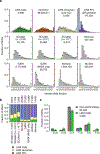Linked-read analysis identifies mutations in single-cell DNA-sequencing data
- PMID: 30886424
- PMCID: PMC6900933
- DOI: 10.1038/s41588-019-0366-2
Linked-read analysis identifies mutations in single-cell DNA-sequencing data
Abstract
Whole-genome sequencing of DNA from single cells has the potential to reshape our understanding of mutational heterogeneity in normal and diseased tissues. However, a major difficulty is distinguishing amplification artifacts from biologically derived somatic mutations. Here, we describe linked-read analysis (LiRA), a method that accurately identifies somatic single-nucleotide variants (sSNVs) by using read-level phasing with nearby germline heterozygous polymorphisms, thereby enabling the characterization of mutational signatures and estimation of somatic mutation rates in single cells.
Conflict of interest statement
Competing Interests
The authors declare no competing interests.
Figures


References
-
- Hou Y et al. Single-Cell Exome Sequencing and Monoclonal Evolution of a JAK2-Negative Myeloproliferative Neoplasm. Cell 148, 873–885 (2012). - PubMed
Publication types
MeSH terms
Grants and funding
LinkOut - more resources
Full Text Sources
Other Literature Sources

